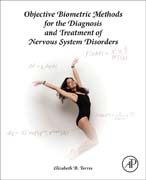
Objective Biometric Methods for the Diagnosis and Treatment of Nervous System Disorders
Torres, Elizabeth B.
Objective Biometric Methods for the Diagnosis and Treatment of Nervous System Disorders provides a new unifying methodological framework and introduces new objective biometrics to characterize patterns of sensory motor control underlying human symptoms in activities of daily living. The main goal is to improve the basic research of disorders of the nervous system and more generally help design better interventions based on objective evaluations of their effectiveness. In this vein, the book also introduces ways to bring the laboratory to the clinical setting, to schools, and the setting of occupational and physical therapy. Ready-to-use graphic user interfaces are introduced to provide outcome measures from wearable sensors that automatically assess in near real time the effectiveness of interventions. Lastly, examples of how the new framework has been effectively utilized in the context of clinical trials are provided. With no books that provide training and detailed examples on the use of objective biometrics on human data, there is a critical need for new methodologies that objectively characterize the physiology underlying many subjective aspects of disease, directly impacting the lives and well-being of individuals. The overarching goal of Objective Biometric Methods for the Diagnosis and Treatment of Nervous System Disorders is to radically transform the ways in which disorders of the nervous systems are currently diagnosed, tracked, researched, and treated. Provides methods and their implementation using real data and simple computer programs that students and researchers from less technically trained fields can useFor each chapter the motivation for the methods according to the problem domain will be explained in light of existing methods along with their lack of neuroscientific foundation and invalid statistical assumptionsChapters will include references (key articles, books, protocols) for additional detailed studyChapters on companion website will contain Appendices with the computer code in MATLAB and the data samples to generate the graphics displayed on the figures of each chapterParadigms will be explained step by step in each clinical or typical sample population to enable reproducibility of the study across different clinical phenotypes and levels of expertise in sports, the performing arts, or mere individual academic predispositions/preferencesVideos illustrating the experimental set up for each situation/method described will be included in each chapter and available on a companion website INDICE: 1. The closed feedback loops between the Peripheral and the Central Nervous Systems, the principle of reafference and its contribution to the definition of the self 2. Critical ingredients for proper social interactions: Rethinking the Mirror Neuron System Theory 3. The case of Autism Spectrum Disorders: When we cannot properly feel our bodies and its motions from the start of our lives 4. The case of Schizophrenia: What happen to perception and how to see it through movement? 5. Late adult onset disorders on a spectrum: How can we differentiate Parkinson from FXTAS and Alzheimer's from Dementia? 6. Traveling from behavioral phenotypic manifestations to genetics origins of a disorder along different time and frequency scales of sensory-motor control 7. Learning to be an expert in Sports and the Performing Arts: Teaching sensory-motor physiology to Psychology Students from the start of their clinical careers 8. Rethinking diagnoses and treatments of disorders: The Third (Objective) Neutral Observer assessing the interactions between the examiner and the examinee or the therapist and the client 9. Taking the lab on the road: Wearable sensors and their benefits when paired with proper analytics 10. Direct applications of stochastic feedback control and closed loop co-adaptive methods to Occupational and Physical therapy: Getting reimbursed by insurance companies 11. Cutting risk, cost and time in clinical trials with the help of Big Pharma
- ISBN: 978-0-12-804082-9
- Editorial: Academic Press
- Encuadernacion: Cartoné
- Páginas: 400
- Fecha Publicación: 01/03/2018
- Nº Volúmenes: 1
- Idioma: Inglés
